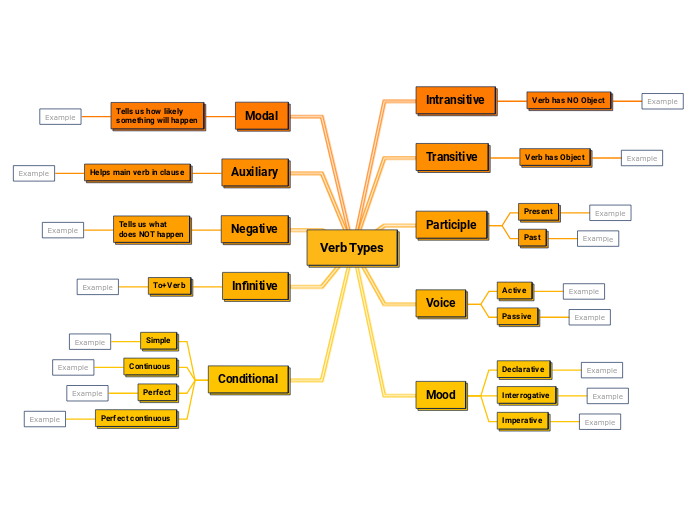{createBy}
{mapViews}
Verb Types
Use this mind map to improve your understanding of how verbs are used in different tenses and practice by creating different contexts.
Keywords: grammar, language

{createBy}
{mapViews}

Mer som dette
As the main word in a sentence, the verb will generally describe an occurrence or an action.
Conditional verbs are used to create conditional sentences, which express hypothetical or unlikely situations. Conditional verbs can be used in the past, present, or future tense, and auxiliary verbs like can/could, will/would, and may/might are important in forming conditionals
An infinitive verb is essentially the base form of a verb with the word 'to' in front of it. When you use an infinitive verb, the 'to' is a part of the verb. It is not acting as a preposition in this case.
The negative verb forms are made by putting not after an auxiliary verb.
Auxiliary verbs are verbs such as have, be, may, do, shall, will, can, or must that are used with another verb to show the verb's tense, to form a question, etc.
A modal verb is a type of verb that is used to indicate modality. Commonly used modal verbs are can, could, must, should, had better, have to and sometimes need or dare.
Grammatical mood refers to the quality or form of a verb in a sentence. More specifically, mood denotes the tone of a verb in a sentence, so the intention of the writer or speaker is clear.
In grammar, the voice of a verb describes the relationship between the action that the verb expresses and the participants identified by its arguments.
A participle is a form of a verb that can be used as an adjective or combined with the verb to be to construct different verb tenses.
A transitive verb will only makes sense if it applies its action on an object.
An intransitive verb has two characteristics:
1.it is an action verb, expressing a doable activity
2.it will not have a direct object receiving the action
Create sentences with examples!
Tankekart hjelper deg med å brainstorme, etablere relasjoner mellom begreper, organisere og generere ideer.
Tankekartmaler er imidlertid en enklere måte å komme i gang på, ettersom de er rammeverk som inneholder informasjon om et bestemt emne med veiledende instruksjoner. Tankekartmaler sørger for en struktur som kombinerer alle elementene i et bestemt emne og fungerer som et utgangspunkt for ditt personlige tankekart. De er en ressurs som gir deg en praktisk løsning for å lage et tankekart om et bestemt emne, enten det er i forbindelse med jobb eller utdanning.
Mindomo gir deg smarte maler for tankekart som gjør at du kan fungere og tenke uanstrengt.
Beskrivende emner
Emner med bakgrunnstekst
Standardgren
Fjerne maldataene
Du kan velge mellom en rekke maler for tankekart fra Mindomos bedrifts- eller utdanningskontoer, eller du kan lage dine egne tankekartmaler fra bunnen av. Et hvilket som helst tankekart kan gjøres om til en mind map-mal ved å legge til flere veiledende notater til et av temaene.